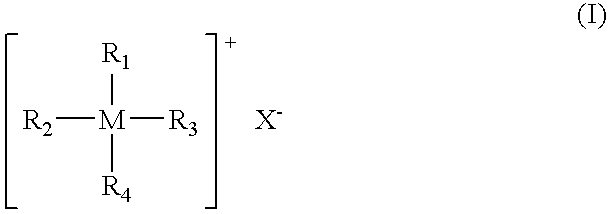Polyamide nanocomposites with oxygen scavenging capability
a technology of polyamide nanocomposites and oxygen scavenging capability, which is applied in the direction of non-metal conductors, conductors, electrochemical generators, etc., can solve the problems of limiting the application of short-term use, insufficient carbon dioxide barrier for bottles containing less than about 4 wt % of mxd6
- Summary
- Abstract
- Description
- Claims
- Application Information
AI Technical Summary
Benefits of technology
Problems solved by technology
Method used
Image
Examples
example 1
Into a 34 / 45, single-neck, 1-liter, round-bottom flask were charged 215.75 grams of a low molecular weight, amine terminated poly(m-xylylene adipamide), with IV of about 0.44 dL / g, 34.25 grams of organo montmorillonite clay containing a tether, octadecyl methyl bis(hydroxyethyl) ammonium chloride, an organoclay available from Southern Clay Products, and 4.23 grams of cobalt(II) acetate tetrahydrate. Under nitrogen atmosphere, the mixture was heated with stirring at 250.degree. C. for 120 minutes then cooled. The material was removed from the flask, ground to pass a 3 mm screen, then stored in a nitrogen atmosphere. X-ray analysis of the product showed the concentration of cobalt in the product to be about 3800 ppm.
Using a Leistritz Micro-18 twin screw extruder, 10 parts of the product was extrusion compounded with 90 parts of MXD6 6007, available from Mitsubishi Gas Company, at a temperature of about 260.degree. C. with screw Speed of about 250 rpm and feed rate of about 2 kg / hr, to...
example 2
Using a Leistritz Micro-18 twin screw extruder, 4 parts of the composite prepared in Example 1 was extrusion compounded with 96 parts of amber PET-20261, available from Eastman Chemical Company, at a temperature of about 275.degree. C. with screw speed of about 300 rpm and feed rate of about 2 kg / hr, and the composite was stored under nitrogen.
Two trilayer films were extruded comprising internal layers of about 30 and 50 vol % of this material with two external layers of PET-9921, available from Eastman Chemical Company. Several 2-inch square ions of the trilayer films were shed using a T.M. Long instrument (4.times.4 orientation at about 110.degree. C.). The carbon dioxide transmission values of the oriented films were determined on a Mocon permeability tester to be 317 and 291 cc(STP)CO.sub.2 / meter.sup.2 / 24 hr, for the 30 and 50 vol % films respectively. Oxygen consumption for 10 grams of the unoriented film comprising 50 vol % of the extrudate of PET 9921 with the nanocomposite...
example 3
This example illustrates the preparation of montmorillonite clay in which 50% of the sodium cations are exchanged with cobalt and 50% with protons. 40 g (38.0 meq of exchangeable sodium) of refined Wyoming type sodium montmorillonite with cation exchange capacity of 0.95 meq / g available from Southern Clay Products was dispersed in 2000 ml of 70.degree. C. water in a Commercial Waring Blender. Then 2.36 g (19 meq) of cobalt(II) acetate tetrahydrate in 200 ml of water was added followed by additional blending. 50 ml of 0.962 N HCl was then added. The mixture was blended, centrifuged, washed with 1000 ml of water in the blender, then centrifuged again. The product was dried in an oven at 60.degree. C. overnight to provide 14.3 g of final product. Ash content was 87.15 wt %, cobalt content was 1.23%, and X-ray basal spacing was 1.25 nm.
13.2 grams of the treated clay, prepared as described above, was dry mixed with 269 parts of a low molecular weight poly(m-xylylene adipamide), with IV o...
PUM
| Property | Measurement | Unit |
|---|---|---|
| weight percent | aaaaa | aaaaa |
| weight percent | aaaaa | aaaaa |
| weight percent | aaaaa | aaaaa |
Abstract
Description
Claims
Application Information
 Login to View More
Login to View More - R&D
- Intellectual Property
- Life Sciences
- Materials
- Tech Scout
- Unparalleled Data Quality
- Higher Quality Content
- 60% Fewer Hallucinations
Browse by: Latest US Patents, China's latest patents, Technical Efficacy Thesaurus, Application Domain, Technology Topic, Popular Technical Reports.
© 2025 PatSnap. All rights reserved.Legal|Privacy policy|Modern Slavery Act Transparency Statement|Sitemap|About US| Contact US: help@patsnap.com



